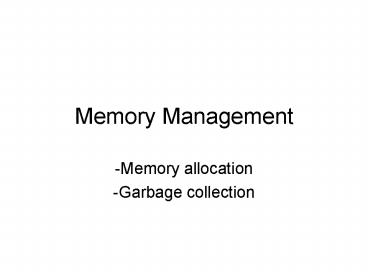Memory Management - PowerPoint PPT Presentation
1 / 16
Title:
Memory Management
Description:
Memory Allocation. Memory pool: large block of contiguous memory ... Dynamic Allocation. Blocks of any size may be requested in any order from the free-list ... – PowerPoint PPT presentation
Number of Views:60
Avg rating:3.0/5.0
Title: Memory Management
1
Memory Management
- Memory allocation
- Garbage collection
2
Memory Allocation
- Memory pool large block of contiguous memory
- Memory manager allocates memory by returning a
handle to the user - Use the term heap to refer to free memory
accessed by a dynamic memory management scheme
3
Dynamic Allocation
- Blocks of any size may be requested in any order
from the free-list - For a request of m words, and a block size k,
between m and k space is used for the request - This can result in fragmentation if m ! k
4
Fragmentation in Dynamic Allocation
- External fragmentation lots of small free blocks
- Internal fragmentation when all of block of size
k is allocated for m words. This type of
allocation is easier, if less efficient
5
Sequential Fit Method
- Attempt to find a good block
- The free-list is organized as a doubly-linked
list - Tag bit and block size fields
- The memory manager searches the free-list for a
block of suitable size
6
Three sequential fit methods
- First fit
- Start from the beginning (or middle)
- May waste larger blocks by breaking them up
- Best fit
- Examines entire list
- Maximizes external fragmentation but will be more
likely to be able to service large requests
7
Three sequential fit methods
- Worst fit
- Allocates largest block through a sequential
search - Minimizes external fragmentation
- Which is best? Depends on the expected types of
memory requests
8
Sequential Fit
- A search of the free-list is in ?(n) in the worst
case - Want to merge adjacent free blocks
- Need additional space to support the memory
manager operations/linked list - Is there anything that can be improved?
9
The Buddy Method
- Assume that memory is of size 2n for some n
- Both free and reserved blocks will be of size 2k
for k n - The buddy system keeps a separate list of free
blocks for each size
10
The Buddy Method
- For a request of size m, find the smallest k
where 2k m - If such a k exists, allocate a block of size 2k
from the list - If such a k does not exist, allocate the next
larger block on the list, and split it in half
until a block of size 2k is created
11
The Buddy Method
- Advantages
- Less external fragmentation
- Cheaper search than a linked list
- Merging adjacent blocks is easy (the buddy for
any block of size 2k is another block of the same
size with the same address except the kth bit is
reversed) - Disadvantage
- Allows internal fragmentation
12
Other memory allocation methods
- Segregated storage method break available memory
into several memory zones, each with its own
management method - Impose a standard size (cluster scheme)
- Example disk file management
- Leads to internal fragmentation
- Does not need to be contiguous
13
Failure Policies
- Happens when a memory request for a certain size
cannot be serviced - Due to external fragmentation ? compact memory,
which physically moves data - Use a handle if the application relies on
absolute positions of the data - Can defer the memory request (for example, when
several processes are running at once)
14
Failure policies Garbage Collection
- When no program variable points to a block of
space, it is considered garbage (or a memory
leak) - Garbage collection involves determining which
memory is garbage and recovering it - Two common methods
- Reference count
- Mark/sweep strategy
15
Garbage Collection
- Reference Count each dynamically allocated
memory block has a count field that is
incremented and decremented for each pointer
pointing to it (or away from it) - When the count reaches zero, the memory becomes
garbage and is immediately placed in free store - Used by the UNIX file system, where the memory
objects are linked together without cycles - Useful when the objects are large, such as a file
16
Garbage Collection
- Mark/sweep strategy
- Uses a single bit marker instead of a count field
- Works for cycles, but DFS is recursive
- Garbage collection phase occurs when free store
is exhausted - Clear all mark bits
- Perform DFS from each pointer on the variable
list, turning on the bits - Sweep through the memory pool for unmarked
elements (which are garbage and placed in free
store)































